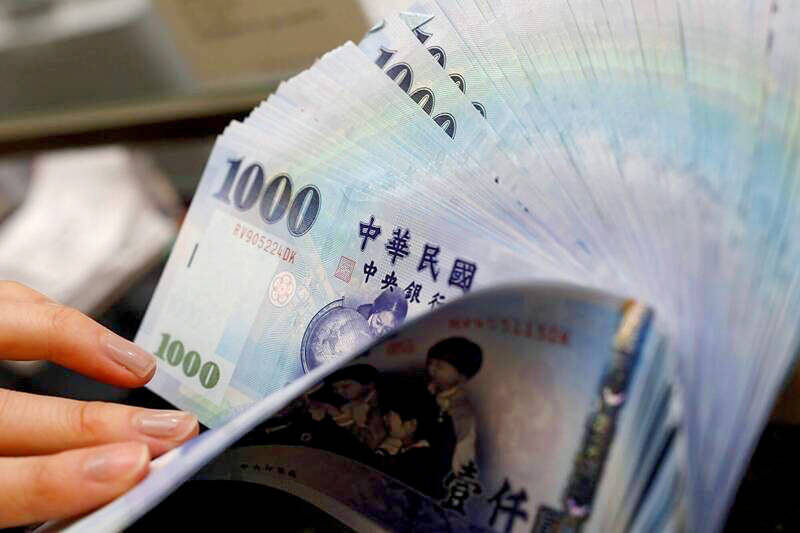The New Taiwan dollar yesterday rallied to its strongest in three years amid inflows to the nation’s stock market and broad-based weakness in the US dollar.
Exporter sales of the US currency and a repatriation of funds from local asset managers also played a role, said two traders, who asked not to be identified as they were not authorized to speak publicly.
State-owned banks were seen buying the greenback yesterday, but only at a moderate scale, the traders said.

Photo: Tyrone Siu, Reuters
The local currency gained 0.77 percent, outperforming almost all of its Asian peers, to close at NT$29.165 per US dollar in Taipei trading yesterday.
The NT dollar’s gain was lower than the yen’s 0.87 percent rise, but ahead of increases of 0.59 percent for the won, 0.48 percent for the Singaporean dollar and 0.06 percent for the yuan, central bank data showed.
There were rumors in the market that the central bank had suggested some large exporters to sell US dollars after 10am to prevent concentrated buying of the NT dollar during the critical market opening hours and avoid strengthening the currency’s appreciation expectation, local media reported.
Market watchers are monitoring whether the central bank would intervene to defend the NT$29 mark against the US dollar after the local currency surpassed NT$29.5 mark early this week.
“The Executive Yuan will continue to pay attention to the NT dollar’s exchange rate and make appropriate responses, while respecting the central bank’s relevant actions,” Executive Yuan spokeswoman Michelle Lee (李慧芝) said yesterday after a Cabinet meeting.
The central bank has told foreign investors to exit bets on the NT dollar, taken through exchange-traded funds (ETFs), as a 12 percent gain in the local currency threatens the country’s economy and companies.
The strategy involves investors buying the ETFs and inverse ETFs, allowing them to accumulate holdings of NT dollars while maintaining a neutral position in the stock market.
Foreign funds have been “repeatedly” deploying that playbook to speculate on the local currency, central bank Deputy Governor Yen Tzung-ta (嚴宗大) said at a meeting of the legislature’s Economics Committee in Taipei on Wednesday. “As soon as we detect it, we immediately request that the funds be remitted out.”
Last month, the NT dollar notched its biggest single-day gain since the 1980s. The almost unprecedented rally is posing a risk to the country’s export-reliant economy and putting pressure on the life insurance industry, which has massive exposure to US dollar assets.
“Local exporters still have a lot of dollars to sell given the strength in exports, and life insurance companies will want to manage their currency risk by hedging more in case of further US dollar weakness,” Australia and New Zealand Banking Group Ltd head of Asia research Khoon Goh (吳昆) said yesterday. “It only seems a matter of time before Taiwan dollar’s key level of 29 is surpassed.”
Additional reporting by staff writer

WEAKER ACTIVITY: The sharpest deterioration was seen in the electronics and optical components sector, with the production index falling 13.2 points to 44.5 Taiwan’s manufacturing sector last month contracted for a second consecutive month, with the purchasing managers’ index (PMI) slipping to 48, reflecting ongoing caution over trade uncertainties, the Chung-Hua Institution for Economic Research (CIER, 中華經濟研究院) said yesterday. The decline reflects growing caution among companies amid uncertainty surrounding US tariffs, semiconductor duties and automotive import levies, and it is also likely linked to fading front-loading activity, CIER president Lien Hsien-ming (連賢明) said. “Some clients have started shifting orders to Southeast Asian countries where tariff regimes are already clear,” Lien told a news conference. Firms across the supply chain are also lowering stock levels to mitigate

IN THE AIR: While most companies said they were committed to North American operations, some added that production and costs would depend on the outcome of a US trade probe Leading local contract electronics makers Wistron Corp (緯創), Quanta Computer Inc (廣達), Inventec Corp (英業達) and Compal Electronics Inc (仁寶) are to maintain their North American expansion plans, despite Washington’s 20 percent tariff on Taiwanese goods. Wistron said it has long maintained a presence in the US, while distributing production across Taiwan, North America, Southeast Asia and Europe. The company is in talks with customers to align capacity with their site preferences, a company official told the Taipei Times by telephone on Friday. The company is still in talks with clients over who would bear the tariff costs, with the outcome pending further

Six Taiwanese companies, including contract chipmaker Taiwan Semiconductor Manufacturing Co (TSMC, 台積電), made the 2025 Fortune Global 500 list of the world’s largest firms by revenue. In a report published by New York-based Fortune magazine on Tuesday, Hon Hai Precision Industry Co (鴻海精密), also known as Foxconn Technology Group (富士康科技集團), ranked highest among Taiwanese firms, placing 28th with revenue of US$213.69 billion. Up 60 spots from last year, TSMC rose to No. 126 with US$90.16 billion in revenue, followed by Quanta Computer Inc (廣達) at 348th, Pegatron Corp (和碩) at 461st, CPC Corp, Taiwan (台灣中油) at 494th and Wistron Corp (緯創) at

NEGOTIATIONS: Semiconductors play an outsized role in Taiwan’s industrial and economic development and are a major driver of the Taiwan-US trade imbalance With US President Donald Trump threatening to impose tariffs on semiconductors, Taiwan is expected to face a significant challenge, as information and communications technology (ICT) products account for more than 70 percent of its exports to the US, Chung-Hua Institution for Economic Research (CIER, 中華經濟研究院) president Lien Hsien-ming (連賢明) said on Friday. Compared with other countries, semiconductors play a disproportionately large role in Taiwan’s industrial and economic development, Lien said. As the sixth-largest contributor to the US trade deficit, Taiwan recorded a US$73.9 billion trade surplus with the US last year — up from US$47.8 billion in 2023 — driven by strong